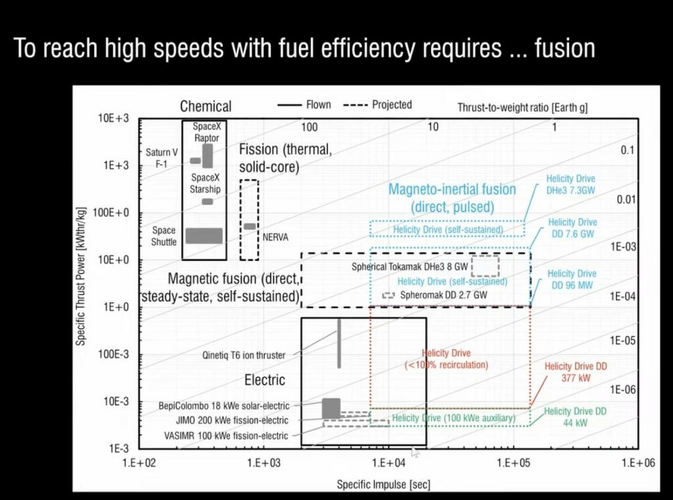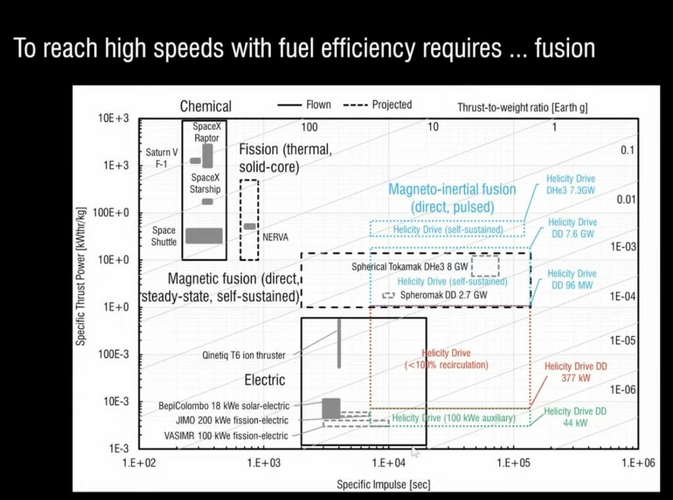Prophet141
ACCESS: Confidential
- Joined
- 25 April 2022
- Messages
- 123
- Reaction score
- 81
I'm sure the fuel, payload, and the engine that's about two storeys tall will all together weigh less than an average man in a spacesuit.
Musk doesn't do hydrogen. Less risky than Starship for now.no sense in risking things on flying on SLS.
1. no, it isn't. Don't need hydrogen anyways.1. Musk doesn't do hydrogen. Less risky than Starship for now.
2. Right now, we have--what--three cores in the pipeline. Put a 10 year manned BEO moratorium due to Orion problems.
3. This could be a windfall for the DARPA NTR guys.
4. If you are going to do NTR---you want as much hydrogen as you can get.
5. As New Glenn comes on line--then kill SLS if you wish.
Nah, ammonia works and requires vastly less volume of tankage. Doesn't completely strangle your ISP, either, and it's stable long term.Number 4 ...if you go to the expense of an NTR, you might as well have the biggest LH2 tank you can find.
Indeed, but you scale the engine and the fuel relative to the size of the ship. So for a 101kg probe and 1m/s^2 you need 59kg/day of fuel and for a 10t ship you need 5.9t of fuel.Right.
And to make 0.85m/s/s on 101newtons of thrust the spaceship weighs how much?
F = m * a, 101=m*0.85, 101/0.85=m, m=118.8kg.

 www.nextbigfuture.com
www.nextbigfuture.com
The ISP would be 7000 to 160000.
The “large” system would get to 55-1000 newtons of thruyst with 30 plasma guns and convert about 100 kilowatts into 1-2 megawatts of power. The very large systems with 170 plasma guns could reach gigawatts of power and tens of thousands of newtons of thrust.

You're talking a 12 day mission and the launch weight doesn't have mass for 12 days.Indeed, but you scale the engine and the fuel relative to the size of the ship. So for a 101kg probe and 1m/s^2 you need 59kg/day of fuel and for a 10t ship you need 5.9t of fuel.
I would agree for the 15,000s Isp Pulsar design. You get ~1 day acceleration at 1m/s at best. Start mass 129.5% of average mass, finish mass 70.5%. With the 160,000s Isp of the Helicity design, then you can get nearly 11 days with the same mass of fuel. But hey, 86.4km/s or 864km/s is still a shed load better than the 11km/s you get with LH2/LOx.You're talking a 12 day mission and the launch weight doesn't have mass for 12 days.
Do you see the problem?


 www.nextbigfuture.com
www.nextbigfuture.com
How is an engine with less than a quarter of the Isp only taking 50% longer than one with 15,000?Bimodal NTR gets you there in 45 days:

New Class of Bimodal NTP/NEP with a Wave Rotor Topping Cycle Enabling Fast Transit to Mars - NASA
Nuclear Thermal Propulsion (NTP) is identified as the preferred propulsion technology for manned missions throughout the solar system. Thewww.nasa.gov

Optimized Nuclear Thermal Rocket for 45 Days to Mars | NextBigFuture.com
Nuclear Thermal Propulsion (NTP) is the preferred propulsion technology for manned missions throughout the solar system. The state-of-the-art NTP cycle iswww.nextbigfuture.com
More
If Helicity isn't blowing smoke---then use theirs for gas/ice giants and such.
NTRs are good enough for Mars, chemical for Luna.
A novel Wave Rotor (WR) topping cycle is proposed that promises to deliver similar thrust as NERVA class NTP propulsion, but with Isp in the 1400-2000 second range. Coupled with an NEP cycle, the duty cycle Isp can further be increased (1800-4000 seconds) with minimal addition of dry mass.
Significantly more thrust.How is an engine with less than a quarter of the Isp only taking 50% longer than one with 15,000?
Isp is fuel efficiency, it has nothing to do with time. Thrust is what determines how fast you get there.
That gives faster acceleration but you still only get a delta V proportional to the Isp for a given mass of fuel, quarter the Isp with X kg of propellant gives quarter the delta V. It only takes 1 day of acceleration with the 15,000s Isp fusion example to reach a speed that gets to Mars in 30 days. Some of Helicity's designs make similar thrust to NTPs but with a much greater Isp.Significantly more thrust.

Am 242 is an order of magnitude or two more expensive than Pu 239.Stan Borowski might be the one to ask.
The first time I heard of an NTR/NEP combo I figured it would limp back empty under NEP after dropping off astronauts.
Rubbia thinks it could take two weeks:
To Mars in Two Weeks?
www.scientificamerican.com
NTR/NEP combos might be best for power generation.....less of a stretch than Fusion.
When Rubbia first mentioned Am 242, we didn't have the technology level we do now.
Time for a revisit?
